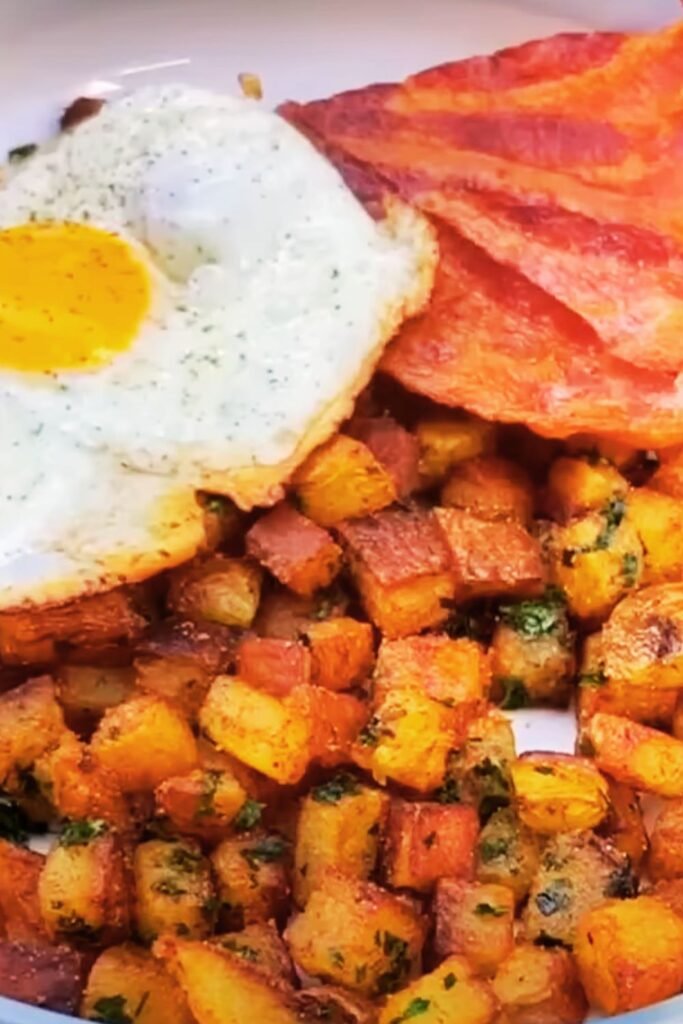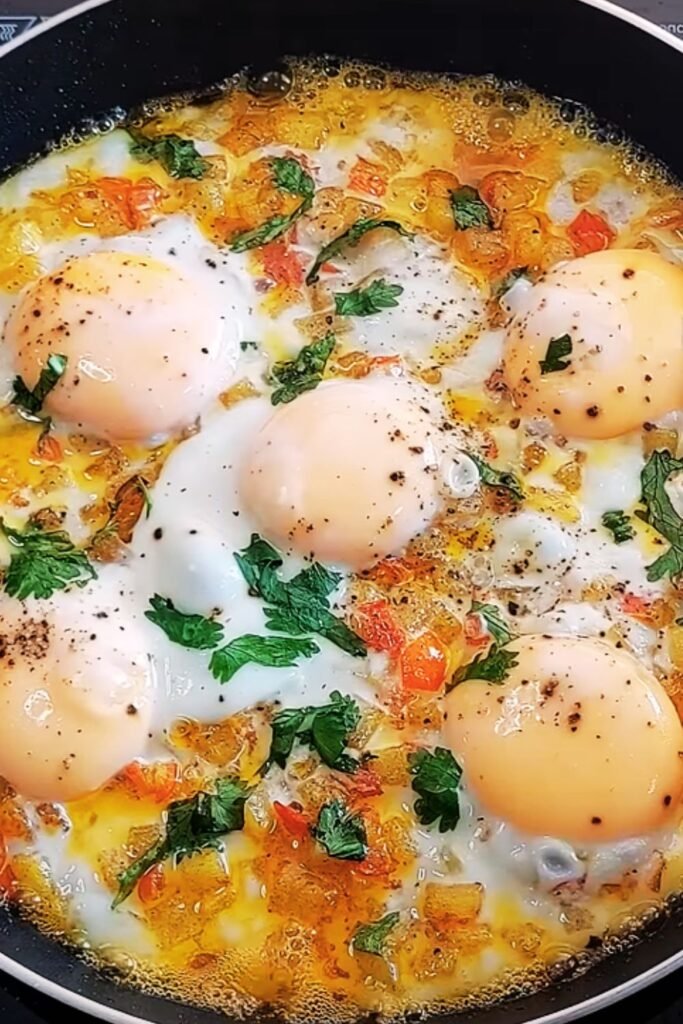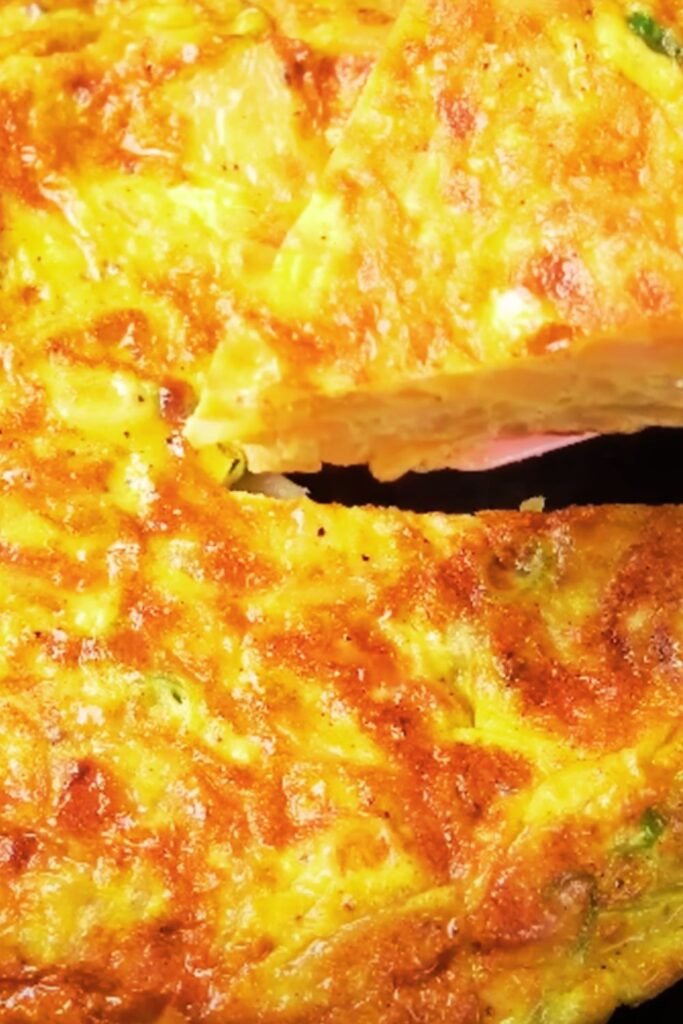There’s something magical about the way Spanish cuisine transforms simple ingredients into extraordinary dishes. When I first encountered authentic Spanish-style eggs with roasted potatoes during a trip to Andalusia, I was struck by how such humble components could create such a satisfying and flavorful meal. The combination of perfectly cooked eggs nestled among golden, crispy potatoes, all infused with the warmth of Spanish spices, became an instant favorite that I’ve been perfecting in my own kitchen ever since.
This traditional dish, often called “Huevos Rotos con Patatas” in Spain, literally translates to “broken eggs with potatoes.” While the name might sound simple, the technique and flavors behind this beloved recipe are anything but ordinary. The dish represents the heart of Spanish home cooking – taking everyday ingredients and elevating them through careful preparation and the generous use of high-quality olive oil.
What makes this dish truly special is its versatility and the way it bridges the gap between breakfast, lunch, and dinner. I’ve served it as a hearty weekend brunch, a satisfying weeknight dinner, and even as part of a tapas spread for entertaining. The beauty lies in its rustic simplicity – there’s no need for perfect presentation when the flavors speak for themselves.
Understanding the Foundation: Key Ingredients and Their Roles
Before diving into the preparation, let me walk you through the essential components that make this dish shine. Each ingredient plays a crucial role in creating the perfect balance of textures and flavors.
Potatoes: The star of the show : Waxy potatoes like Yukon Gold or fingerlings work best as they hold their shape during roasting while developing a golden, crispy exterior. I prefer cutting them into irregular chunks rather than perfect cubes – this creates more surface area for that coveted golden crust.
Eggs: The crowning touch : Fresh, high-quality eggs are non-negotiable. The yolks should be bright orange and the whites firm but not rubbery. Room temperature eggs cook more evenly and are less likely to crack when added to the hot pan.
Spanish Olive Oil: The flavor foundation : Extra virgin olive oil isn’t just a cooking medium here – it’s a flavor component. Spanish olive oil tends to be more robust and fruity than other varieties, adding depth to every bite. Don’t be shy with it; authentic Spanish cooking is generous with olive oil.
Garlic: The aromatic backbone : Fresh garlic cloves, thinly sliced or minced, provide the aromatic foundation. I always use fresh – never powdered – as the flavor difference is remarkable.
Spanish Paprika (Pimentón): The signature spice : Sweet Spanish paprika is what gives this dish its distinctive color and smoky flavor. If you can find Spanish pimentón dulce, use it. The difference in flavor complexity compared to regular paprika is significant.

Nutritional Profile and Health Benefits
Understanding what you’re putting into your body makes every meal more meaningful. This Spanish-style egg and potato dish offers surprising nutritional benefits when prepared thoughtfully.
| Nutrient Category | Per Serving | Daily Value % | Health Benefits |
|---|---|---|---|
| Protein | 18-22g | 36-44% | Supports muscle maintenance and satiety |
| Healthy Fats | 15-20g | 23-31% | From olive oil and eggs; supports heart health |
| Complex Carbs | 35-40g | 12-13% | Sustained energy from potatoes |
| Vitamin B12 | 1.2mcg | 50% | Essential for nerve function and red blood cell formation |
| Choline | 250mg | 45% | Important for brain health and memory |
| Potassium | 800mg | 17% | Supports heart health and muscle function |
| Vitamin D | 40-80 IU | 10-20% | Bone health and immune function |
| Folate | 40mcg | 10% | Important for cell division and DNA synthesis |
The Mediterranean diet principles shine through in this dish. The abundant use of olive oil provides monounsaturated fats that support cardiovascular health, while eggs contribute high-quality complete protein. Potatoes, often unfairly maligned, actually provide important nutrients including vitamin C, potassium, and fiber when prepared with the skin on.
Step-by-Step Preparation: Mastering the Technique
Creating perfect Spanish-style eggs with roasted potatoes requires attention to timing and technique. I’ve refined my approach over countless iterations, and I’m excited to share the methods that consistently deliver restaurant-quality results at home.
Phase 1: Preparing the Potatoes
The foundation of this dish starts with properly prepared potatoes. I’ve found that the key to achieving that perfect balance of crispy exterior and fluffy interior lies in the preparation and cooking method.
- Selection and Cutting: Choose medium-sized waxy potatoes, about 2-3 inches in diameter. Wash them thoroughly but leave the skin on – it adds texture and nutrition. Cut into irregular chunks, roughly 1.5-2 inches. The irregular shape creates more surface area for browning.
- Pre-salting: Toss the cut potatoes with coarse sea salt and let them sit for 15 minutes. This draws out excess moisture and helps create a better crust during roasting.
- Oil Temperature: Heat your olive oil to approximately 325°F (163°C) in a large, heavy-bottomed skillet or cast-iron pan. The oil should be about 1/2 inch deep – more than you might expect, but this is authentic Spanish style.
- Initial Cooking: Add the potatoes to the oil in a single layer. Don’t overcrowd; work in batches if necessary. Cook for 8-10 minutes without moving them, allowing a golden crust to form.
- Gentle Movement: Using a wooden spoon, gently turn the potatoes. Continue cooking for another 6-8 minutes until golden brown on all sides and tender when pierced with a fork.

Phase 2: Creating the Aromatic Base
While the potatoes are finishing their cooking, it’s time to build the flavor foundation that will elevate this dish from good to extraordinary.
- Garlic Preparation: Slice 4-5 garlic cloves thinly. The key is uniform thickness so they cook evenly without burning.
- Oil Management: Once the potatoes are golden and tender, remove them with a slotted spoon and set aside on paper towels. Leave about 2-3 tablespoons of the flavored oil in the pan.
- Garlic Cooking: Reduce heat to medium-low and add the sliced garlic to the oil. Cook gently for 1-2 minutes until fragrant and just beginning to turn golden. Be careful not to brown it too much as it will continue cooking.
- Paprika Addition: Remove the pan from heat and immediately add 1-2 teaspoons of Spanish paprika, stirring quickly to prevent burning. The residual heat will bloom the spices perfectly.
Phase 3: The Egg Technique
The eggs are what transform this from a simple potato dish into something truly special. The technique here is crucial for achieving the perfect “broken egg” texture that gives the dish its name.
- Return to Heat: Add the potatoes back to the pan with the garlic oil, gently tossing to coat with the paprika-infused oil.
- Creating Wells: Using a wooden spoon, create small wells or indentations in the potato mixture where the eggs will nest.
- Egg Addition: Crack each egg into a small bowl first, then gently pour into the prepared wells. This prevents broken yolks and ensures even distribution.
- Controlled Cooking: Cook on medium heat for 3-4 minutes, allowing the whites to set while keeping the yolks slightly runny. The edges of the whites should be just set but not crispy.
- Final Seasoning: Season with sea salt and freshly ground black pepper. Add a sprinkle of fresh herbs if desired.
Regional Variations and Personal Adaptations
During my culinary explorations across Spain, I discovered that every region – and indeed every family – has its own interpretation of this classic dish. These variations have inspired me to experiment and develop my own adaptations while respecting the traditional foundation.
Andalusian Style
In southern Spain, particularly around Seville, I encountered versions that include thin slices of jamón ibérico added just before the eggs. The rendered fat from the ham adds another layer of richness and smokiness that complements the paprika beautifully.
Basque Influence
The Basque region’s version often incorporates roasted red peppers (pimientos del piquillo) and sometimes includes a touch of cayenne for heat. I’ve adapted this by adding strips of roasted bell peppers during the final cooking phase.
My Modern Interpretations
Through experimentation, I’ve developed several variations that maintain the dish’s integrity while adding contemporary touches:
- Herb-Crusted Version: I sometimes add fresh thyme and rosemary to the potatoes during the final roasting phase
- Cheese Addition: A sprinkle of aged Manchego cheese just before serving adds richness without overwhelming the traditional flavors
- Vegetable Enhancement: Roasted cherry tomatoes or asparagus spears can be incorporated for additional color and nutrition
Detailed Cooking Timeline and Temperature Guide
Mastering this dish requires understanding the precise timing and temperatures involved. I’ve developed this comprehensive guide based on extensive testing in various kitchen conditions.
| Cooking Phase | Time Required | Temperature | Key Indicators |
|---|---|---|---|
| Potato Prep | 15 minutes | Room temp | Moisture drawn out, potatoes appear dry |
| Initial Oil Heating | 5-7 minutes | 325°F (163°C) | Oil shimmers but doesn’t smoke |
| First Potato Cook | 8-10 minutes | 325°F (163°C) | Golden crust forms, no movement |
| Potato Turning | 6-8 minutes | 325°F (163°C) | All sides golden, fork-tender |
| Garlic Cooking | 1-2 minutes | Medium-low | Fragrant, light golden color |
| Paprika Blooming | 30 seconds | Off heat | Color deepens, aromatic |
| Egg Cooking | 3-4 minutes | Medium heat | Whites set, yolks still soft |
| Final Assembly | 2-3 minutes | Low heat | Heated through, seasoned |
Troubleshooting Common Issues
Over the years, I’ve encountered and solved numerous challenges that home cooks face when preparing this dish. Here are the most common issues and my proven solutions:
Problem: Potatoes become mushy instead of crispy Solution: Ensure potatoes are properly dried after salting, and maintain oil temperature. Overcrowding the pan also prevents proper crisping.
Problem: Garlic burns before eggs are added Solution: Remove the pan from heat when adding paprika and garlic. The residual heat is sufficient to cook them gently.
Problem: Eggs overcook and become rubbery Solution: Use medium heat and watch carefully. The whites should be just set – they’ll continue cooking from residual heat.
Problem: Dish lacks flavor depth Solution: Don’t skimp on the olive oil, and ensure you’re using high-quality Spanish paprika. The oil carries and amplifies all the flavors.

Serving Suggestions and Accompaniments
The beauty of Spanish-style eggs with roasted potatoes lies in its versatility. I’ve served this dish in countless contexts, and each setting brings out different aspects of its character.
Traditional Spanish Presentation
Serve directly from the cooking pan with crusty bread (pan tostado) for dipping into the rich, yolk-enriched oil. This rustic presentation is authentic and practical, keeping the eggs warm while highlighting the dish’s humble, homestyle origins.
Modern Plating Options
For more formal occasions, I transfer the dish to warmed individual plates, ensuring each serving gets both crispy potatoes and a perfectly cooked egg. A light drizzle of good olive oil and a sprinkle of coarse sea salt finish the presentation beautifully.
Complementary Side Dishes
- Spanish Tomato Bread (Pan con Tomate): The acidity cuts through the richness perfectly
- Simple Green Salad: Dressed with sherry vinegar and olive oil to maintain the Spanish theme
- Roasted Vegetables: Especially bell peppers, zucchini, or eggplant
- Spanish Rice: Plain white rice absorbs the flavorful oils beautifully
Beverage Pairings
Strong coffee or café con leche works wonderfully for brunch service. For dinner, consider Spanish sparkling water with lemon or traditional horchata for a cooling contrast to the rich, warm dish.
Storage and Reheating Guidelines
While this dish is best enjoyed immediately, I understand that meal planning sometimes requires advance preparation or dealing with leftovers.
Make-Ahead Strategies
The potatoes can be partially cooked up to 4 hours in advance. Cool completely and store covered at room temperature. When ready to serve, reheat the potatoes in the oil before adding the eggs.
Leftover Management
Unfortunately, eggs don’t reheat well once fully cooked, so I recommend eating this dish fresh. However, leftover potatoes make an excellent base for hash or can be chopped and added to tortillas or frittatas.
Storage Tips
If you must store leftovers, refrigerate in an airtight container for no more than 24 hours. Reheat gently in a covered pan with a splash of olive oil, being careful not to overcook any remaining egg elements.
Nutritional Modifications and Dietary Adaptations
Understanding that dietary needs vary, I’ve experimented with several modifications that maintain the dish’s essential character while accommodating different requirements.
Lower-Fat Version
While olive oil is central to authentic preparation, you can reduce the amount by using a non-stick pan and adding oil gradually as needed. The dish will lose some traditional richness but remains flavorful.
Protein Boost
For those needing additional protein, consider adding:
- Crumbled Spanish chorizo (cooked separately to avoid grease)
- Diced serrano ham
- White beans (cannellini or great northern)
Vegetarian Enhancements
To make the dish more substantial for vegetarian diners:
- Add roasted vegetables like bell peppers, zucchini, or tomatoes
- Include chickpeas or white beans for additional protein and fiber
- Incorporate fresh herbs like parsley, chives, or oregano
Cultural Context and Historical Background
Understanding the cultural significance of this dish has deepened my appreciation for its simplicity and enduring popularity. Spanish-style eggs with potatoes represents the essence of Spanish home cooking – making the most of available ingredients with technique and tradition.
The dish likely evolved during the 18th and 19th centuries when potatoes became widely cultivated in Spain. The combination reflects the Spanish approach to cooking: generous with olive oil, respectful of ingredients’ natural flavors, and focused on bringing people together around the table.
In Spain, this dish bridges social and economic classes. It’s equally at home in a humble family kitchen and an upscale tapas bar. This democratic nature is something I find deeply appealing – good food doesn’t require expensive ingredients, just care and skill in preparation.
Questions and Answers
Q: What type of potatoes work best for this recipe? I recommend waxy potatoes like Yukon Gold, Red Bliss, or fingerlings. These varieties hold their shape well during cooking and develop a beautiful golden crust while maintaining a fluffy interior. Avoid russet potatoes as they tend to fall apart and don’t crisp as nicely.
Q: Can I use regular paprika instead of Spanish pimentón? While you can substitute regular paprika, Spanish pimentón dulce has a distinctly different flavor profile – it’s smokier and more complex. If you can’t find Spanish paprika, look for smoked paprika as a closer substitute, though use it sparingly as it can be quite intense.
Q: How do I know when the oil is the right temperature for the potatoes? The oil should shimmer but not smoke, typically around 325°F (163°C). If you don’t have a thermometer, test with a small piece of potato – it should sizzle gently when added, not violently bubble or sit quietly.
Q: What’s the secret to getting perfectly runny egg yolks? Cook the eggs on medium heat and watch them carefully. The whites should be just set but still slightly jiggly, and the yolks should feel soft when gently pressed with a spatula. Remember that the eggs continue cooking from residual heat even after you remove the pan from the burner.
Q: Can I make this dish dairy-free? Absolutely! The traditional recipe is naturally dairy-free, using only olive oil, potatoes, eggs, garlic, and spices. Just be sure to check that any additional ingredients you might add (like chorizo or bread for serving) don’t contain dairy.
Q: How can I prevent the garlic from burning? The key is temperature control. Cook the garlic on medium-low heat and watch it carefully. Remove the pan from heat when adding the paprika, as the residual heat is enough to bloom the spices without burning the garlic.
Q: Is it necessary to use so much olive oil? The generous amount of olive oil is essential to authentic Spanish cooking and contributes significantly to the dish’s flavor and texture. However, if you’re concerned about the amount, you can reduce it slightly, though the dish won’t be quite the same.
Q: Can I add other vegetables to this dish? Certainly! Roasted bell peppers, cherry tomatoes, or asparagus work beautifully. Add heartier vegetables like peppers during the potato cooking phase, and more delicate items like tomatoes just before adding the eggs.
Q: What’s the best way to serve this for a crowd? For entertaining, I prepare the potatoes in advance and reheat them in large skillets or sheet pans in the oven. Then I crack the eggs into individual ramekins and add them to the reheated potatoes, finishing everything in the oven at 350°F until the whites are set.
Q: How spicy is this dish with the paprika? Spanish sweet paprika (pimentón dulce) is not spicy at all – it’s mild and adds smoky sweetness rather than heat. If you want some spice, you can add a pinch of cayenne pepper or use hot Spanish paprika (pimentón picante) instead.